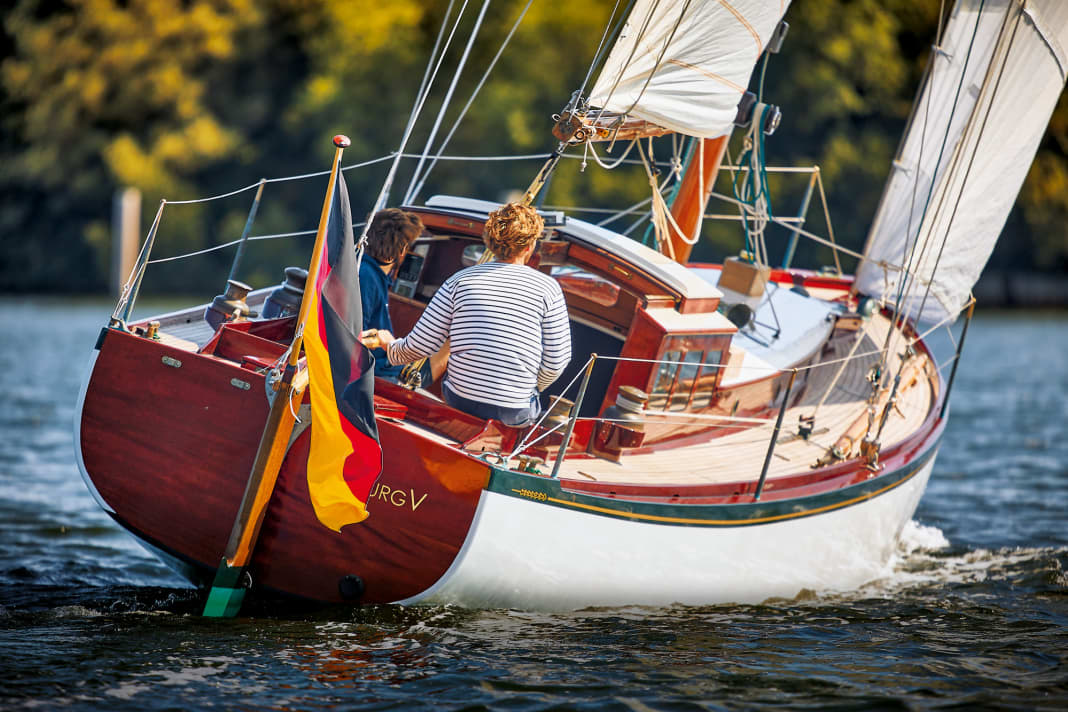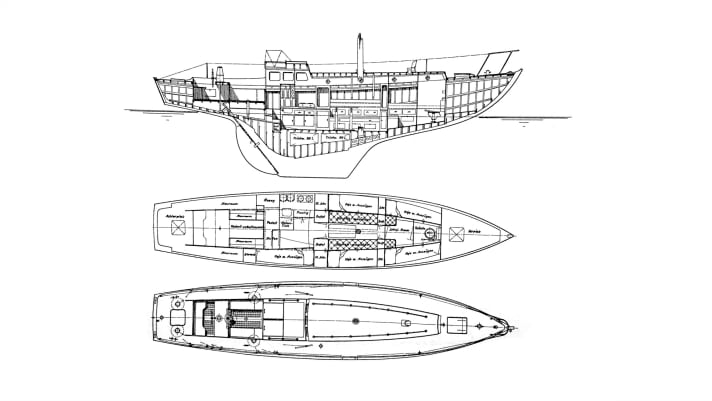Late luck: "Hamburg V" - Germany's first light displacement ocean-going yacht






Veerhaven in Holland in May 2020: The "Hamburg V" has just arrived after a trial run with its new owner. After mooring, two co-sailors set to work steering the bilge. They have a lot to do.
Owner Jo Vierbaum sits absently on the superstructure and tries to sort out his circling thoughts. Under sail, the yacht, which was painstakingly restored by the previous owner only ten years ago, has just turned out to be a labour-intensive project. But the purchase contract has been signed, the transfer to the Schlei has been planned for a long time, and together with his two accompanying employees, master boat builder Vierbaum has already put a week's work into the mast in order to be able to set it at all.
The "Hamburg V" has always been considered difficult to sail
And in addition to these hard facts, idealism has also long been at play. Because what they have rigged up here is not just any classic - the "Hamburg V" is the first light displacement ocean-going yacht built in Germany. The Hamburgischer Verein Seefahrt had her designed and built by Henry Rasmussen for the RORC survey just four years after the end of the Second World War. The ship only served the association for a few years; it was considered difficult to sail. It passed through many hands in Belgium and Holland. But nobody really warmed to the historically significant yacht.
He was fighting back tears, says Vierbaum, looking back on the moment after the trial run. Today, the ship floats in the harbour of the Stapelfeldt yacht and boatyard, which he manages. Vierbaum sits in the cockpit of the "Hamburg V", with which he has just sailed confidently and confidently across the Schlei and - unlike in his account of the first trip - seems extremely satisfied.
His first boat was already moored here in Kappeln-Grauhöft, a self-built piece of jewellery, ready for a holiday and - from that point of view - not even in need of a new one. However, they wanted to create more space on the water for their growing family, so the Vierbaums took a look at the boat market from time to time. The "Hamburg V" caught their eye some time ago.
Exotic with Rasmussen's signature
The ship is indeed a sight to behold. The hull is long and narrow, the deck is a spiritedly curved line in Rasmussen's signature style, above it a discreet superstructure with classic portholes that ends in a striking deckhouse. The freeboard is white, the redwoods are natural varnished and the glossy varnished softwood spars are honey-coloured. Below deck, the "Hamburg V", designed as a crew boat, is ideal for a growing family crew. There are numerous single berths, a spacious saloon, light space in the deckhouse, a large cockpit and plenty of storage space everywhere.
The ship is being offered by a Dutchman who had it restored at a shipyard ten years previously. In the photos in the sales advert, the "Hamburg V" looks as it did when it was delivered by Abeking & Rasmussen. The varnished timbers gleam in the sun, the unconventional interior with the navigation station in the companionway, the cockpit with separate space for the helmsman behind his tiny spoked wheel - everything corresponds exactly to the plans signed with Rasmussen's bold abbreviations.
It is said that he was not at all enthusiastic about the idea of introducing the light displacement fashion that had spilled over from Great Britain and the USA onto the European continent towards the end of the 1940s. Before the Second World War, the increasingly popular ocean racing developed its own measurement rules - the CCA formula of the Cruising Club of America and the RORC formula of the British Royal Ocean Racing Club. After the war, experience with light boats in ocean races, born out of necessity, showed that they had advantages in certain conditions.
Way ahead of its time
The "Myth of Malham", probably the first lightweight displacement yacht, was developed in 1947. Laurent Giles and John Illingworth designed the ship to the lower limit of the weight possible according to the RORC formula with regard to its other dimensions. The "Myth" owed her strength to double-diagonal planking on a framework of stringers.
The design also broke with tradition. The ship made a name for itself as a futuristic appearance, but above all through numerous regatta victories. And so the evolution of ocean-going yachts seemed to have reached a new level at the end of the 1940s. The "Myth of Malham" was regarded by open-minded clients at the time as a trailblazer for new designs.
It is not known why the old master Henry Rasmussen could not come to terms with this development. What is known, however, is that the Danish-born designer was a conservative and aesthete through and through. And that the design brought about by lightweight displacement did not at all correspond to the widespread ideal of the beautiful sailing yacht at the time.
A design that breaks with convention
The first appearance of the "Hamburg V" at the Kieler Woche was described as follows in YACHT, issue 4 of 1951: "Although the 'Hamburg' does not have an extremely modern shape compared to the new English light displacement yachts, when she was later moored in Kiel's Olympic harbour, she aroused pronounced dislike and displeasure among many sailors. We are simply used to other shapes and have a fairly well-defined ideal of beauty."
Henry Rasmussen himself did not even mention this historically significant yachting episode in his autobiography "Yachts, Sailors and a Shipyard". However, after a summer of familiarisation, this short chapter didn't start off too badly.
In her first season in 1950, "Hamburg V" was entered for the North Sea Week and, just three weeks after being commissioned, took part in the offshore race around Skagen. She only came fourth in her group after her conventionally built rivals "Roland von Bremen", "Tanja" and "Atalanta".
The race around Fehmarn during Kiel Week even had to be cancelled. Strong winds from the south-west forced the crew to sail into the Great Belt with the new boat, which was still unfamiliar.
"Hamburg V": successful at domestic regattas
But in the 1951 season, the world looked very different. As the RORC formula had been changed during the construction of the yacht, the stern and sail plan were modified once again at Abeking & Rasmussen in the winter of 1950/51 and a new measurement was taken. It was now possible to sail forwards, especially in medium winds. The "Hamburg V" took first place in the Cuxhaven-Helgoland and Cuxhaven-Hörnum races and the following summer at the Glückstadt Regatta. In the summer of 1953, the HVS took a first and a second place at the North Sea Week and in the summer of 1954 first places in the Cuxhaven-Helgoland race, the Aalregatta and Fehmarn Rund.
But then a successor was commissioned. The "Hamburg V" was primarily successful in regional regattas sailed according to the KR formula, but the lightweight displacement was unable to assert itself in international RORC regattas. The chroniclers report on ocean races in which the new designs were unable to capitalise on their advantages because they were not able to planing for as long as hoped. On the other hand, the conventional yachts proved to be superior in heavy seas because they were slowed down less.
What is known about the sailing characteristics of the "Hamburg V" at the time is that she was considered to be overly sensitive at the helm and in terms of longitudinal trim, both at the helm and under spinnaker. And: "She was also pretty lean," remembers HVS member Conrad Poppenhusen to this day. The 18-year-old from Hamburg was there when the ship was christened. He particularly remembers the unusual layout of the yacht, with navigation in the dog house. The sea behaviour, on the other hand, is described as very good. The ship sails dry and moves "like a duck across the sea".
Arrived with new owners
It is of no use to her. In the summer of 1955, the ship is only sailed on five weekends, and the following spring the club sells it to Belgium. From its new home port of Antwerp, the yacht, now called "Tenace II", sailed under the banner of the Royal Belgian Yacht Club, later as "Keikop" in Holland, where it was one day acquired by an enthusiast who had it restored by Rexwinkel in Numansdorp in 2007 and renamed it "Hamburg V" again.
It is a total refurbishment that is true to the original and includes the stern and deadwood, keel bolts and floor cradles as well as the planking of the outer skin. This is worth as much to the owner as a comparably sized ship would cost new. And in the end, the appearance of the ageing ship actually resembles the state in which it was delivered. However, this also applies to the design weaknesses that catch the eye of today's owner as soon as he sets sail.
"The ship was still tight at the berth, but under sail it ran like a waterfall," recalls Jo Vierbaum, who noticed a lot of movement in the area of the keel attachment, where the mast is located, which led to the leak. But his mind was made up. Together with his mates, he provisionally seals the hull and sets sail for the Limfjord via Terschelling and Helgoland, where the family gets on board.
The trip was a complete success, but the sailing was no fun. "It was joyless," says Vierbaum looking back. The ship was sluggish, difficult to steer and, with its heavy rigging, it quickly lay on its side without setting off. But he recognised the potential in the crack. And the behaviour in rough seas and the balanced directional stability encouraged him to fix the problems.
Sailing is also fun with optimised rudder and rigging
At the shipyard at home, Vierbaum moves the rudder to the transom. Then he takes weight out of the rig. The heavy wooden mast is planed through and the solid bronze fittings are replaced with lighter carbon fibre ones. The cutter is turned into a slip, so that the "Hamburg V" can now manage with several fewer wires and no more backstays need to be operated. And the two furling systems have given way to a thin Dyneema forestay.
The forces of the rig are better transferred in the hull and the mast is placed on a longer base. Planks are replaced and seams repaired. On deck, new paint surfaces are created after damaged areas of the gunwale and toe rail have been repaired. The prominent chart table disappears from the deckhouse.
The children, says Vierbaum, claimed the ship as their own from the very first moment. He himself experienced a slow approach that had a lot to do with working on the extraordinary classic.
But when he sits on the edge today, the tiller jib in his hand, and enjoys the completely new sailing behaviour of the boat that he now calls "his" without hesitation, Jo Vierbaum is happy about the decision he made after the first trial run in Holland.
Technical data "Hamburg V"
- Designer: H. Rasmussen
- Year of construction: 1949/50
- Length:12,60 m
- Waterline length:9,50 m
- Width:2,80 m
- Depth: 2,20 m
- Displacement:8,5 t
- sail area:65 square metres
- Shipyard:Abeking & Rasmussen


